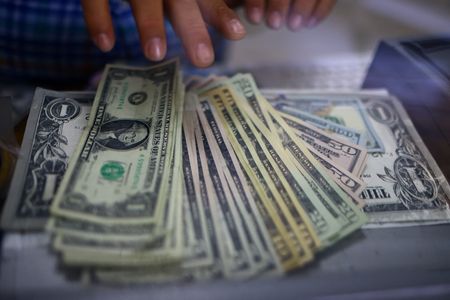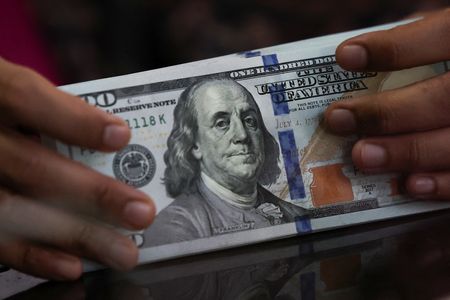By Gregor Stuart Hunter
SINGAPORE (Reuters) -The U.S. dollar softened on Monday as signs the federal government could soon reopen buoyed investor confidence after a string of weak economic data.
The dollar index, which tracks the greenback’s strength against a basket of six major currencies, slid 0.1% to 99.643 after the Senate voted to advance a measure that could fund the U.S. government through January.
“This is just in the nick of time,” said Tony Sycamore, market analyst at IG in Sydney. “The retreat we saw in the U.S. dollar into the end of last week probably continues now.”
On Friday, the University of Michigan’s consumer sentiment index weakened to its lowest level in nearly 3-1/2 years in early November, close to its all-time nadir, as the government shutdown stretched into the longest in history.
“The consumer confidence data was a shocker and pretty clear evidence that the shutdown was affecting households, so this does alleviate the damage that’s been done,” Sycamore added, referring to the prospect of an end to the shutdown.
On prediction market Polymarket, the implied probability that the shutdown would end before November 15 surged to 92%.
Against the yen, the dollar appreciated 0.2% to 153.80 yen, following comments from Japanese Prime Minister Sanae Takaichi on Monday that she would work on setting a new fiscal target extending through several years to allow more flexible spending, essentially watering down the country’s commitment to fiscal consolidation.
The Bank of Japan’s summary of opinions on Monday also said that the “fog surrounding Japan’s economic outlook has begun to clear compared with July.”
Traders are assessing the impact of U.S. President Donald Trump’s economic policies, which had sparked a rush of production earlier in the year ahead of a U.S. deadline to implement tariffs on foreign imports. Data over the weekend showed Chinese consumer price inflation rose more quickly than expected, which followed on the heels of the government reporting the biggest drop in exports since February.
“We expect a renewed downshift in Asia’s economic growth now that export front-loading has largely run its course,” Eric Robertsen, global head of research and chief strategist at Standard Chartered Bank, wrote in a research note. “And with the region’s rate-cutting cycle nearly complete, we expect inflows to local assets to slow,” he said.
“We also see a risk that the abundant global liquidity that has supported global assets in 2025 could become less supportive in 2026,” he added. “This may suggest further gains for the U.S. dollar over the next 12 months.”
Investors are reining in bets on further rate cuts from the U.S. central bank. The yield on benchmark 10-year Treasury notes jumped 4.26 basis points to 4.1356% compared with its U.S. close of 4.093% on Friday.
Trading of Fed funds futures implies a 63% probability of a 25-basis-point cut to interest rates at the Federal Reserve’s next meeting on December 10, down from 67% on Friday, according to the CME Group’s FedWatch tool.
The euro was 0.1% weaker at $1.1559, while sterling changed hands at $1.3148, 0.1% softer on the day.
The offshore yuan was at 7.1204 against the dollar, unchanged in Asian trading.
The Australian dollar was last 0.4% firmer at $0.6520, while the kiwi edged 0.1% higher to $0.5632.
(Reporting by Gregor Stuart Hunter; Editing by Shri Navaratnam and Kim Coghill)









